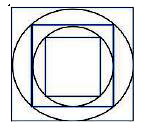Show that of all the rectangles of given area, the square has the smallest perimeter.
To show that of all rectangles with a given area, the square has the smallest perimeter, we can follow these steps:
Step 1: Define the Variables
Let the dimensions of the rectangle be x and y. The area A of the rectangle is given by:
A=x⋅y
This area is fixed.
Step 2: Express Perimeter in Terms of One Variable
The perimeter P of the rectangle is given by:
P=2(x+y)
Since the area is fixed, we can express y in terms of x:
y=Ax
Substituting this expression for y into the perimeter formula gives:
P=2(x+Ax)
Step 3: Differentiate the Perimeter Function
Now we need to minimize P. We will differentiate P with respect to x:
P=2(x+Ax)
Differentiating P:
dPdx=2(1−Ax2)
Step 4: Set the Derivative Equal to Zero
To find the critical points, we set the derivative equal to zero:
1−Ax2=0
Solving for x:
Ax2=1⇒x2=A⇒x=√A
(Note: We discard the negative root since dimensions cannot be negative.)
Step 5: Find the Corresponding y
Using x=√A to find y:
y=Ax=A√A=√A
Thus, we have x=y=√A, which means the rectangle is a square.
Step 6: Verify Minimum Using Second Derivative Test
To confirm that this critical point is a minimum, we compute the second derivative:
d2Pdx2=ddx(2(1−Ax2))=2(2Ax3)
Since A>0 and x>0, we have:
d2Pdx2>0
This indicates that P has a local minimum at x=√A.
Conclusion
Thus, we have shown that for a fixed area A, the rectangle with the smallest perimeter is indeed a square with side length √A.
---
Let the dimensions of the rectangle be x and y. The area A of the rectangle is given by:
A=x⋅y
This area is fixed.
The perimeter P of the rectangle is given by:
P=2(x+y)
Since the area is fixed, we can express y in terms of x:
y=Ax
Substituting this expression for y into the perimeter formula gives:
P=2(x+Ax)
Now we need to minimize P. We will differentiate P with respect to x:
P=2(x+Ax)
Differentiating P:
dPdx=2(1−Ax2)
To find the critical points, we set the derivative equal to zero:
1−Ax2=0
Solving for x:
Ax2=1⇒x2=A⇒x=√A
(Note: We discard the negative root since dimensions cannot be negative.)
Using x=√A to find y:
y=Ax=A√A=√A
Thus, we have x=y=√A, which means the rectangle is a square.
To confirm that this critical point is a minimum, we compute the second derivative:
d2Pdx2=ddx(2(1−Ax2))=2(2Ax3)
Since A>0 and x>0, we have:
d2Pdx2>0
This indicates that P has a local minimum at x=√A.
Thus, we have shown that for a fixed area A, the rectangle with the smallest perimeter is indeed a square with side length √A.
Topper's Solved these Questions
Similar Questions
Statement I :Among all the rectangles of the given perimeter, the square has the largest area. Also among all the rectangles of given area, the square has the least perimeter.
Statement II :For x>0,y>0,ifx+y= constant, then xy will be maximum for y=x and if xy=constant, then x+y will be minimum for y=x.View SolutionShow that all the rectangles with a given perimeter, the square has the largest area.
View Solution
Knowledge Check
- Question 1 - Select One
Perimeter of a square is 28 cm and length of the rectangle is 8 cm. If the perimeter of the square and the rectangle are equal, then the area (in cm2 ) of the rectangle is
A48B24C84D47
Show that all the rectangles with a given perimeter, the square has the largest area.
View SolutionShow that of all the rectangles in a given fixed circle, the square has the maximum area.
(##NTN_MATH_XII_C06_E04_252_Q01.png" width="80%">View SolutionShow that of all the rectangles inscribed in a given circle, the square has the maximum area.
View SolutionShow that of all the rectangles inscribed in a given fixed circle, the square has the maximum area.
View SolutionShow that the largest rectangle with a given perimeter is a square.
View SolutionGiven the sum of the perimeters of a square and a circle, show that the sum of their areas is least when one side of the square is equal to diameter of the circle.
View Solution
In the given figure, the ratio of the area of the largest square to that of the smallest square is:View Solution

